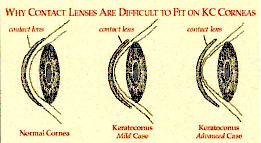Keratoconus and Contact Lenses
Keratoconus (ectatic corneal dystrophy) is a progressive, debilitating bilateral eye disease in which degenerative thinning of the cornea results in complex irregular bulging of the normally round, spherical cornea (the clear covering in front of the eye). Keratoconus results in grossly distorted vision, causing ghosting and glare similar to looking through a windshield while driving in a rainstorm without using windshield wipers. Keratoconus is characterized by thinning and protrusion of the central cornea, resulting in visual distortion, photophobia, halos around lights, decreased vision, and monocular diplopia (double-vision).
Those with keratoconus suffer from decreased vision which cannot be corrected with spectacles or conventional contact lenses. However, most keratoconic patients can achieve functional vision with specially designed therapeutic contact lenses.
Our doctors at Vision Care Consultants are nationally recognized experts in keratoconus and are on the National Keratoconus Foundation’s (NKF) referral lists of doctors.
 Keratoconus is one of the few conditions where contact lenses are a medical necessity (other conditions include unilateral aphakia, post corneal transplant, and very high myopia). It is well documented that rigid gas permeable contact lenses or a combination of a rigid gas permeable lens riding on a soft lens configuration are the treatment of choice for keratoconus.
Keratoconus is one of the few conditions where contact lenses are a medical necessity (other conditions include unilateral aphakia, post corneal transplant, and very high myopia). It is well documented that rigid gas permeable contact lenses or a combination of a rigid gas permeable lens riding on a soft lens configuration are the treatment of choice for keratoconus.
These uniquely designed keratoconic lenses improve vision by providing a clear optical lens that masks the distorted areas of the cornea, creating a smooth, regular optical surface over the patient’s very irregular, cone-shaped cornea. These lenses can mask the distorted vision caused by keratoconus and can provide the required visual acuity necessary to perform daily routines. Without these corrective lenses these patients are visually handicapped. They would not be able to hold a job and therefore support themselves and their families. They would not be able to perform even the simplest tasks of daily life: read, drive a car, attend school or even recognize a face across the room.
Spectacles cannot achieve these results. The lenses in a pair of glasses are too far away from the optical surface of the cornea to create the smooth refractive surface necessary to translate the image clearly to the back of the eye and therefore to the brain.
These therapeutic contact lenses are not cosmetic. They are specially designed devices that treat a medical problem. Just as a leg brace helps a patient to walk, these therapeutic contact lenses provide a treatment plan to improve the quality of life.
The only other therapeutic option for rehabilitating vision in the keratoconus patient is penetrating keratoplasty (corneal transplant surgery). Because of the inherent risks with surgery and high cost, this option is only reserved for patients who cannot receive treatment from contact lenses.
